题目:压缩感知重构算法之压缩采样匹配追踪(CoSaMP)
压缩采样匹配追踪(CompressiveSampling MP)是D. Needell继ROMP之后提出的又一个具有较大影响力的重构算法。CoSaMP也是对OMP的一种改进,每次迭代选择多个原子,除了原子的选择标准之外,它有一点不同于ROMP:ROMP每次迭代已经选择的原子会一直保留,而CoSaMP每次迭代选择的原子在下次迭代中可能会被抛弃。
0、符号说明如下:
压缩观测y=Φx,其中y为观测所得向量M×1,x为原信号N×1(M<<N)。x一般不是稀疏的,但在某个变换域Ψ是稀疏的,即x=Ψθ,其中θ为K稀疏的,即θ只有K个非零项。此时y=ΦΨθ,令A=ΦΨ,则y=Aθ。
(1) y为观测所得向量,大小为M×1
(2)x为原信号,大小为N×1
(3)θ为K稀疏的,是信号在x在某变换域的稀疏表示
(4) Φ称为观测矩阵、测量矩阵、测量基,大小为M×N
(5) Ψ称为变换矩阵、变换基、稀疏矩阵、稀疏基、正交基字典矩阵,大小为N×N
(6)A称为测度矩阵、传感矩阵、CS信息算子,大小为M×N
上式中,一般有K<<M<<N,后面三个矩阵各个文献的叫法不一,以后我将Φ称为测量矩阵、将Ψ称为稀疏矩阵、将A称为传感矩阵。
注意:这里的稀疏表示模型为x=Ψθ,所以传感矩阵A=ΦΨ;而有些文献中稀疏模型为θ=Ψx,而一般Ψ为Hermite矩阵(实矩阵时称为正交矩阵),所以Ψ-1=ΨH (实矩阵时为Ψ-1=ΨT),即x=ΨHθ,所以传感矩阵A=ΦΨH,例如沙威的OMP例程中就是如此。
1、CoSaMP重构算法流程:
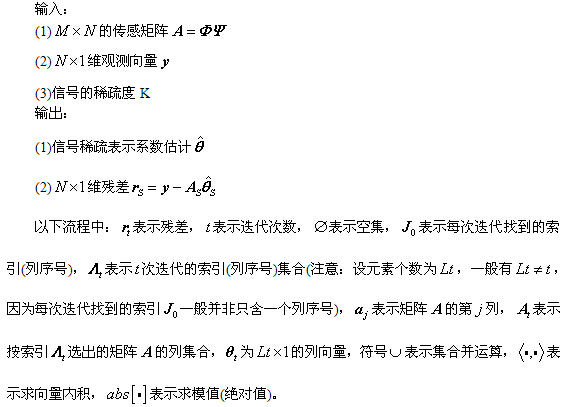
2、压缩采样匹配追踪(CoSaOMP)Matlab代码(CS_CoSaMP.m)
代码参考了文献[5]中的Demo_CS_CoSaMP.m,也可参考文献[6],或者文献[7]中的cosamp.m。值得一提的是文献[5]的所有代码都挺不错的,从代码注释中可以得知作者是ustc的ChengfuHuo,百度一下可知是中国科技大学的霍承富博士,已于2012年6月毕业,博士论文题目是《超光谱遥感图像压缩技术研究》,向这位学长致敬!(虽然不是一个学校的)
2015-05-13更新:
- function [ theta ] = CS_CoSaMP( y,A,K )
- %CS_CoSaOMP Summary of this function goes here
- %Created by jbb0523@@2015-04-29
- %Version: 1.1 modified by jbb0523 @2015-05-09
- % Detailed explanation goes here
- % y = Phi * x
- % x = Psi * theta
- % y = Phi*Psi * theta
- % 令 A = Phi*Psi, 则y=A*theta
- % K is the sparsity level
- % 现在已知y和A,求theta
- % Reference:Needell D,Tropp J A.CoSaMP:Iterative signal recovery from
- % incomplete and inaccurate samples[J].Applied and Computation Harmonic
- % Analysis,2009,26:301-321.
- [y_rows,y_columns] = size(y);
- if y_rows<y_columns
- y = y';%y should be a column vector
- end
- [M,N] = size(A);%传感矩阵A为M*N矩阵
- theta = zeros(N,1);%用来存储恢复的theta(列向量)
- Pos_theta = [];%用来迭代过程中存储A被选择的列序号
- r_n = y;%初始化残差(residual)为y
- for kk=1:K%最多迭代K次
- %(1) Identification
- product = A'*r_n;%传感矩阵A各列与残差的内积
- [val,pos]=sort(abs(product),'descend');
- Js = pos(1:2*K);%选出内积值最大的2K列
- %(2) Support Merger
- Is = union(Pos_theta,Js);%Pos_theta与Js并集
- %(3) Estimation
- %At的行数要大于列数,此为最小二乘的基础(列线性无关)
- if length(Is)<=M
- At = A(:,Is);%将A的这几列组成矩阵At
- else%At的列数大于行数,列必为线性相关的,At'*At将不可逆
- if kk == 1
- theta_ls = 0;
- end
- break;%跳出for循环
- end
- %y=At*theta,以下求theta的最小二乘解(Least Square)
- theta_ls = (At'*At)^(-1)*At'*y;%最小二乘解
- %(4) Pruning
- [val,pos]=sort(abs(theta_ls),'descend');
- %(5) Sample Update
- Pos_theta = Is(pos(1:K));
- theta_ls = theta_ls(pos(1:K));
- %At(:,pos(1:K))*theta_ls是y在At(:,pos(1:K))列空间上的正交投影
- r_n = y - At(:,pos(1:K))*theta_ls;%更新残差
- if norm(r_n)<1e-6%Repeat the steps until r=0
- break;%跳出for循环
- end
- end
- theta(Pos_theta)=theta_ls;%恢复出的theta
- end
function [ theta ] = CS_CoSaMP( y,A,K )
%CS_CoSaOMP Summary of this function goes here
%Created by jbb0523@@2015-04-29
%Version: 1.1 modified by jbb0523 @2015-05-09
% Detailed explanation goes here
% y = Phi * x
% x = Psi * theta
% y = Phi*Psi * theta
% 令 A = Phi*Psi, 则y=A*theta
% K is the sparsity level
% 现在已知y和A,求theta
% Reference:Needell D,Tropp J A.CoSaMP:Iterative signal recovery from
% incomplete and inaccurate samples[J].Applied and Computation Harmonic
% Analysis,2009,26:301-321.
[y_rows,y_columns] = size(y);
if y_rows<y_columns
y = y';%y should be a column vector
end
[M,N] = size(A);%传感矩阵A为M*N矩阵
theta = zeros(N,1);%用来存储恢复的theta(列向量)
Pos_theta = [];%用来迭代过程中存储A被选择的列序号
r_n = y;%初始化残差(residual)为y
for kk=1:K%最多迭代K次
%(1) Identification
product = A'*r_n;%传感矩阵A各列与残差的内积
[val,pos]=sort(abs(product),'descend');
Js = pos(1:2*K);%选出内积值最大的2K列
%(2) Support Merger
Is = union(Pos_theta,Js);%Pos_theta与Js并集
%(3) Estimation
%At的行数要大于列数,此为最小二乘的基础(列线性无关)
if length(Is)<=M
At = A(:,Is);%将A的这几列组成矩阵At
else%At的列数大于行数,列必为线性相关的,At'*At将不可逆
if kk == 1
theta_ls = 0;
end
break;%跳出for循环
end
%y=At*theta,以下求theta的最小二乘解(Least Square)
theta_ls = (At'*At)^(-1)*At'*y;%最小二乘解
%(4) Pruning
[val,pos]=sort(abs(theta_ls),'descend');
%(5) Sample Update
Pos_theta = Is(pos(1:K));
theta_ls = theta_ls(pos(1:K));
%At(:,pos(1:K))*theta_ls是y在At(:,pos(1:K))列空间上的正交投影
r_n = y - At(:,pos(1:K))*theta_ls;%更新残差
if norm(r_n)<1e-6%Repeat the steps until r=0
break;%跳出for循环
end
end
theta(Pos_theta)=theta_ls;%恢复出的theta
end- function [ theta ] = CS_CoSaMP( y,A,K )
- %CS_CoSaMP Summary of this function goes here
- %Version: 1.0 written by jbb0523 @2015-04-29
- % Detailed explanation goes here
- % y = Phi * x
- % x = Psi * theta
- % y = Phi*Psi * theta
- % 令 A = Phi*Psi, 则y=A*theta
- % K is the sparsity level
- % 现在已知y和A,求theta
- % Reference:Needell D,Tropp J A.CoSaMP:Iterative signal recovery from
- % incomplete and inaccurate samples[J].Applied and Computation Harmonic
- % Analysis,2009,26:301-321.
- [y_rows,y_columns] = size(y);
- if y_rows<y_columns
- y = y';%y should be a column vector
- end
- [M,N] = size(A);%传感矩阵A为M*N矩阵
- theta = zeros(N,1);%用来存储恢复的theta(列向量)
- Pos_theta = [];%用来迭代过程中存储A被选择的列序号
- r_n = y;%初始化残差(residual)为y
- for kk=1:K%最多迭代K次
- %(1) Identification
- product = A'*r_n;%传感矩阵A各列与残差的内积
- [val,pos]=sort(abs(product),'descend');
- Js = pos(1:2*K);%选出内积值最大的2K列
- %(2) Support Merger
- Is = union(Pos_theta,Js);%Pos_theta与Js并集
- %(3) Estimation
- %At的行数要大于列数,此为最小二乘的基础(列线性无关)
- if length(Is)<=M
- At = A(:,Is);%将A的这几列组成矩阵At
- else%At的列数大于行数,列必为线性相关的,At'*At将不可逆
- break;%跳出for循环
- end
- %y=At*theta,以下求theta的最小二乘解(Least Square)
- theta_ls = (At'*At)^(-1)*At'*y;%最小二乘解
- %(4) Pruning
- [val,pos]=sort(abs(theta_ls),'descend');
- %(5) Sample Update
- Pos_theta = Is(pos(1:K));
- theta_ls = theta_ls(pos(1:K));
- %At(:,pos(1:K))*theta_ls是y在At(:,pos(1:K))列空间上的正交投影
- r_n = y - At(:,pos(1:K))*theta_ls;%更新残差
- if norm(r_n)<1e-6%Repeat the steps until r=0
- break;%跳出for循环
- end
- end
- theta(Pos_theta)=theta_ls;%恢复出的theta
- end
function [ theta ] = CS_CoSaMP( y,A,K )
%CS_CoSaMP Summary of this function goes here
%Version: 1.0 written by jbb0523 @2015-04-29
% Detailed explanation goes here
% y = Phi * x
% x = Psi * theta
% y = Phi*Psi * theta
% 令 A = Phi*Psi, 则y=A*theta
% K is the sparsity level
% 现在已知y和A,求theta
% Reference:Needell D,Tropp J A.CoSaMP:Iterative signal recovery from
% incomplete and inaccurate samples[J].Applied and Computation Harmonic
% Analysis,2009,26:301-321.
[y_rows,y_columns] = size(y);
if y_rows<y_columns
y = y';%y should be a column vector
end
[M,N] = size(A);%传感矩阵A为M*N矩阵
theta = zeros(N,1);%用来存储恢复的theta(列向量)
Pos_theta = [];%用来迭代过程中存储A被选择的列序号
r_n = y;%初始化残差(residual)为y
for kk=1:K%最多迭代K次
%(1) Identification
product = A'*r_n;%传感矩阵A各列与残差的内积
[val,pos]=sort(abs(product),'descend');
Js = pos(1:2*K);%选出内积值最大的2K列
%(2) Support Merger
Is = union(Pos_theta,Js);%Pos_theta与Js并集
%(3) Estimation
%At的行数要大于列数,此为最小二乘的基础(列线性无关)
if length(Is)<=M
At = A(:,Is);%将A的这几列组成矩阵At
else%At的列数大于行数,列必为线性相关的,At'*At将不可逆
break;%跳出for循环
end
%y=At*theta,以下求theta的最小二乘解(Least Square)
theta_ls = (At'*At)^(-1)*At'*y;%最小二乘解
%(4) Pruning
[val,pos]=sort(abs(theta_ls),'descend');
%(5) Sample Update
Pos_theta = Is(pos(1:K));
theta_ls = theta_ls(pos(1:K));
%At(:,pos(1:K))*theta_ls是y在At(:,pos(1:K))列空间上的正交投影
r_n = y - At(:,pos(1:K))*theta_ls;%更新残差
if norm(r_n)<1e-6%Repeat the steps until r=0
break;%跳出for循环
end
end
theta(Pos_theta)=theta_ls;%恢复出的theta
end在程序主循环的(3)Estimation部分增加了以下几行代码,以使函数运行更加稳定:
- if kk == 1
- theta_ls = 0;
- end
if kk == 1
theta_ls = 0;
end3、CoSaMP单次重构测试代码
以下测试代码基本与OMP单次重构测试代码一样。
- %压缩感知重构算法测试
- clear all;close all;clc;
- M = 64;%观测值个数
- N = 256;%信号x的长度
- K = 12;%信号x的稀疏度
- Index_K = randperm(N);
- x = zeros(N,1);
- x(Index_K(1:K)) = 5*randn(K,1);%x为K稀疏的,且位置是随机的
- Psi = eye(N);%x本身是稀疏的,定义稀疏矩阵为单位阵x=Psi*theta
- Phi = randn(M,N);%测量矩阵为高斯矩阵
- A = Phi * Psi;%传感矩阵
- y = Phi * x;%得到观测向量y
- %% 恢复重构信号x
- tic
- theta = CS_CoSaMP( y,A,K );
- x_r = Psi * theta;% x=Psi * theta
- toc
- %% 绘图
- figure;
- plot(x_r,'k.-');%绘出x的恢复信号
- hold on;
- plot(x,'r');%绘出原信号x
- hold off;
- legend('Recovery','Original')
- fprintf('\n恢复残差:');
- norm(x_r-x)%恢复残差
%压缩感知重构算法测试
clear all;close all;clc;
M = 64;%观测值个数
N = 256;%信号x的长度
K = 12;%信号x的稀疏度
Index_K = randperm(N);
x = zeros(N,1);
x(Index_K(1:K)) = 5*randn(K,1);%x为K稀疏的,且位置是随机的
Psi = eye(N);%x本身是稀疏的,定义稀疏矩阵为单位阵x=Psi*theta
Phi = randn(M,N);%测量矩阵为高斯矩阵
A = Phi * Psi;%传感矩阵
y = Phi * x;%得到观测向量y
%% 恢复重构信号x
tic
theta = CS_CoSaMP( y,A,K );
x_r = Psi * theta;% x=Psi * theta
toc
%% 绘图
figure;
plot(x_r,'k.-');%绘出x的恢复信号
hold on;
plot(x,'r');%绘出原信号x
hold off;
legend('Recovery','Original')
fprintf('\n恢复残差:');
norm(x_r-x)%恢复残差运行结果如下:(信号为随机生成,所以每次结果均不一样)
1)图:
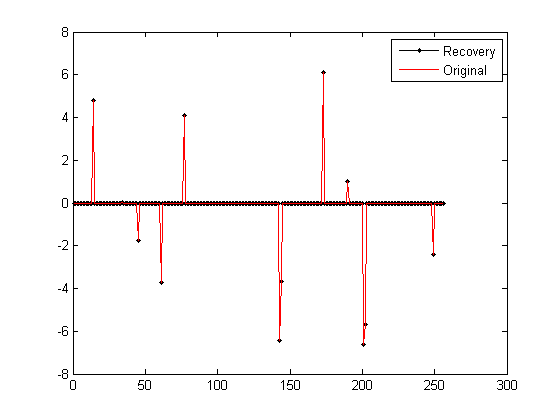
2)Command windows
Elapsedtime is 0.073375 seconds.
恢复残差:
ans=
7.3248e-015
4、测量数M与重构成功概率关系曲线绘制例程代码
以下测试代码基本与OMP测量数M与重构成功概率关系曲线绘制代码一样。增加了“fprintf('K=%d,M=%d\n',K,M);”,可以观察程序运行进度。- clear all;close all;clc;
- %% 参数配置初始化
- CNT = 1000;%对于每组(K,M,N),重复迭代次数
- N = 256;%信号x的长度
- Psi = eye(N);%x本身是稀疏的,定义稀疏矩阵为单位阵x=Psi*theta
- K_set = [4,12,20,28,36];%信号x的稀疏度集合
- Percentage = zeros(length(K_set),N);%存储恢复成功概率
- %% 主循环,遍历每组(K,M,N)
- tic
- for kk = 1:length(K_set)
- K = K_set(kk);%本次稀疏度
- M_set = 2*K:5:N;%M没必要全部遍历,每隔5测试一个就可以了
- PercentageK = zeros(1,length(M_set));%存储此稀疏度K下不同M的恢复成功概率
- for mm = 1:length(M_set)
- M = M_set(mm);%本次观测值个数
- fprintf('K=%d,M=%d\n',K,M);
- P = 0;
- for cnt = 1:CNT %每个观测值个数均运行CNT次
- Index_K = randperm(N);
- x = zeros(N,1);
- x(Index_K(1:K)) = 5*randn(K,1);%x为K稀疏的,且位置是随机的
- Phi = randn(M,N)/sqrt(M);%测量矩阵为高斯矩阵
- A = Phi * Psi;%传感矩阵
- y = Phi * x;%得到观测向量y
- theta = CS_CoSaMP(y,A,K);%恢复重构信号theta
- x_r = Psi * theta;% x=Psi * theta
- if norm(x_r-x)<1e-6%如果残差小于1e-6则认为恢复成功
- P = P + 1;
- end
- end
- PercentageK(mm) = P/CNT*100;%计算恢复概率
- end
- Percentage(kk,1:length(M_set)) = PercentageK;
- end
- toc
- save CoSaMPMtoPercentage1000 %运行一次不容易,把变量全部存储下来
- %% 绘图
- S = ['-ks';'-ko';'-kd';'-kv';'-k*'];
- figure;
- for kk = 1:length(K_set)
- K = K_set(kk);
- M_set = 2*K:5:N;
- L_Mset = length(M_set);
- plot(M_set,Percentage(kk,1:L_Mset),S(kk,:));%绘出x的恢复信号
- hold on;
- end
clear all;close all;clc;
%% 参数配置初始化
CNT = 1000;%对于每组(K,M,N),重复迭代次数
N = 256;%信号x的长度
Psi = eye(N);%x本身是稀疏的,定义稀疏矩阵为单位阵x=Psi*theta
K_set = [4,12,20,28,36];%信号x的稀疏度集合
Percentage = zeros(length(K_set),N);%存储恢复成功概率
%% 主循环,遍历每组(K,M,N)
tic
for kk = 1:length(K_set)
K = K_set(kk);%本次稀疏度
M_set = 2*K:5:N;%M没必要全部遍历,每隔5测试一个就可以了
PercentageK = zeros(1,length(M_set));%存储此稀疏度K下不同M的恢复成功概率
for mm = 1:length(M_set)
M = M_set(mm);%本次观测值个数
fprintf('K=%d,M=%d\n',K,M);
P = 0;
for cnt = 1:CNT %每个观测值个数均运行CNT次
Index_K = randperm(N);
x = zeros(N,1);
x(Index_K(1:K)) = 5*randn(K,1);%x为K稀疏的,且位置是随机的
Phi = randn(M,N)/sqrt(M);%测量矩阵为高斯矩阵
A = Phi * Psi;%传感矩阵
y = Phi * x;%得到观测向量y
theta = CS_CoSaMP(y,A,K);%恢复重构信号theta
x_r = Psi * theta;% x=Psi * theta
if norm(x_r-x)<1e-6%如果残差小于1e-6则认为恢复成功
P = P + 1;
end
end
PercentageK(mm) = P/CNT*100;%计算恢复概率
end
Percentage(kk,1:length(M_set)) = PercentageK;
end
toc
save CoSaMPMtoPercentage1000 %运行一次不容易,把变量全部存储下来
%% 绘图
S = ['-ks';'-ko';'-kd';'-kv';'-k*'];
figure;
for kk = 1:length(K_set)
K = K_set(kk);
M_set = 2*K:5:N;
L_Mset = length(M_set);
plot(M_set,Percentage(kk,1:L_Mset),S(kk,:));%绘出x的恢复信号
hold on;
end本程序在联想ThinkPadE430C笔记本(4GBDDR3内存,i5-3210)上运行共耗时1102.325890秒,程序中将所有数据均通过“save CoSaMPMtoPercentage1000”存储了下来,以后可以再对数据进行分析,只需“load CoSaMPMtoPercentage1000”即可。
本程序运行结果:
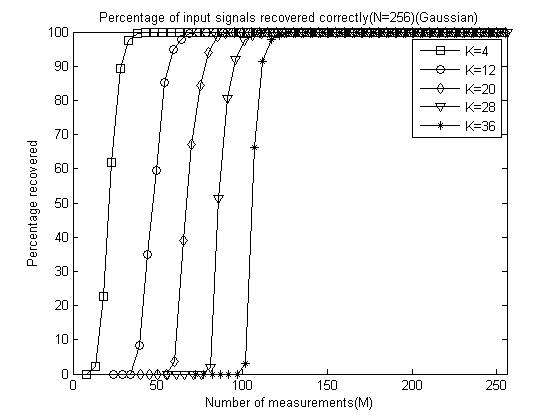
5、结语
有关CoSaMP的原始引用文献共有四个版本,分别如参考文献[1][2][3][4],可依据链接下载,其中[1]和[2]基本一致,本人主要看的是文献[2]。
有关CoSaMP的算法流程,可参见参考文献[2]:
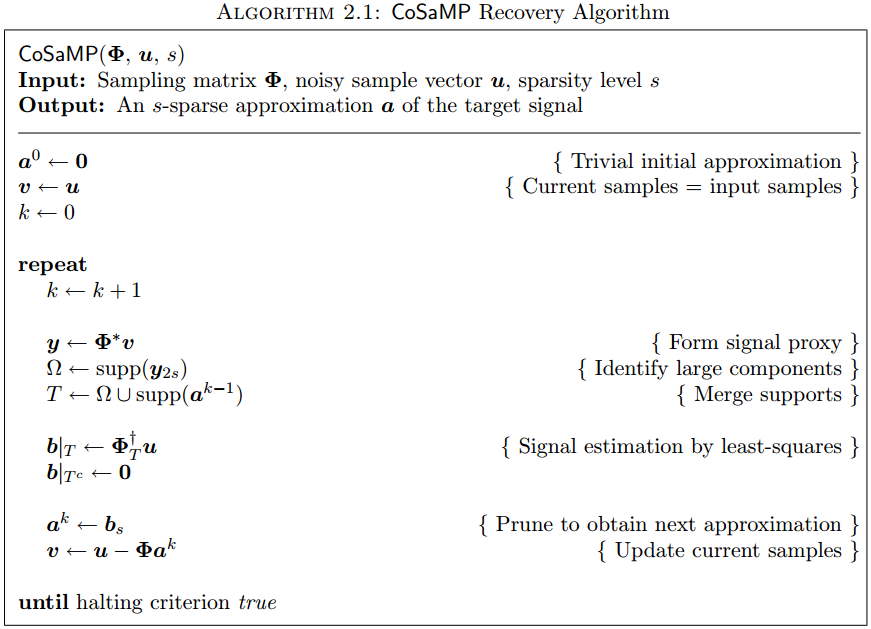
这个流程中的其它部分都可以看懂,就是那句“b|Tc←0”很不明白,“Tc”到底是指的什么呢?现在看来应该是T的补集(complementary set),向量b的元素序号为全集,子集T对应的元素等于最小二乘解,补集对应的元素为零。
有关算法流程中的“注3”提到的迭代次数,在文献[2]中多处有提及,不过面向的问题不同,可以文献[2]中搜索“Iteration Count”,以下给出三处:


文献[8]的3.4节提到“设算法的迭代步长为K,候选集中最多有3K个原子,每次最多剔除K个原子,以保证支撑集中有2K个原子”,对这个观点我保留意见,我认为应该是“每次最多剔除2K个原子,以保证支撑集中有K个原子”。
参考文献:
[1]D. Needell, J.A. Tropp, CoSaMP: Iterative signal recovery from incomplete andinaccurate samples, ACM Technical Report 2008-01, California Institute ofTechnology, Pasadena, 2008.
(http://authors.library.caltech.edu/27169/)
[2]D. Needell, J.A. Tropp.CoSaMP: Iterative signal recoveryfrom incomplete and inaccurate samples.http://arxiv.org/pdf/0803.2392v2.pdf
[3] D. Needell, J.A. Tropp.CoSaMP:Iterativesignal recovery from incomplete and inaccurate samples[J].Appliedand Computation Harmonic Analysis,2009,26:301-321.
(http://www.sciencedirect.com/science/article/pii/S1063520308000638)
[4]D.Needell, J.A. Tropp.CoSaMP: Iterative signal recoveryfrom incomplete and inaccurate samples[J]. Communications of theACM,2010,53(12):93-100.
(http://dl.acm.org/citation.cfm?id=1859229)
[5]Li Zeng. CS_Reconstruction.http://www.pudn.com/downloads518/sourcecode/math/detail2151378.html
[6]wanghui.csmp. http://www.pudn.com/downloads252/sourcecode/others/detail1168584.html
[7]付自杰.cs_matlab. http://www.pudn.com/downloads641/sourcecode/math/detail2595379.html
[8]杨真真,杨震,孙林慧.信号压缩重构的正交匹配追踪类算法综述[J]. 信号处理,2013,29(4):486-496.







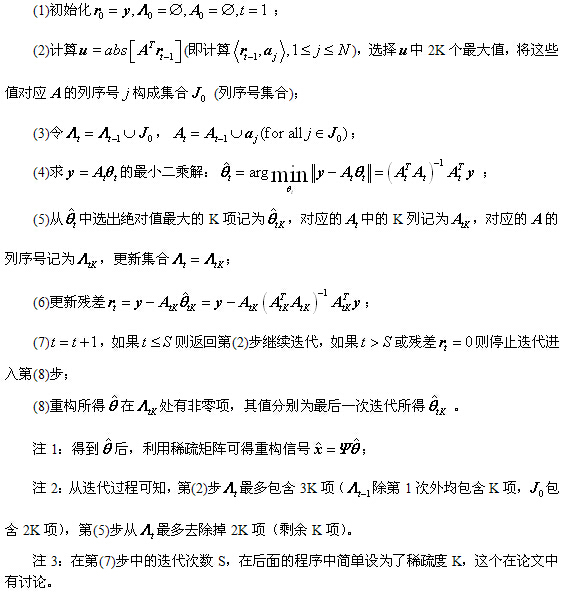















 5万+
5万+

 被折叠的 条评论
为什么被折叠?
被折叠的 条评论
为什么被折叠?








